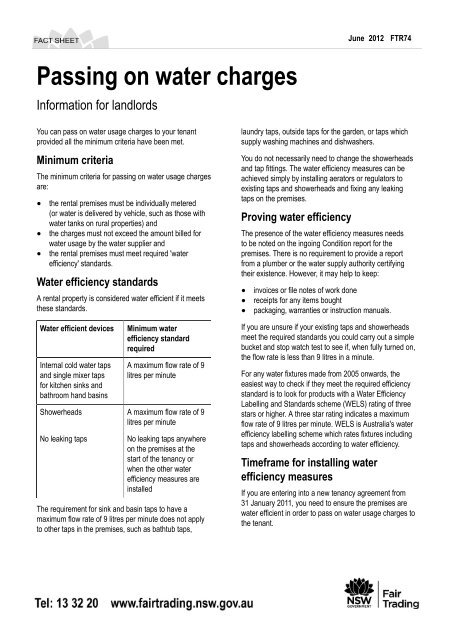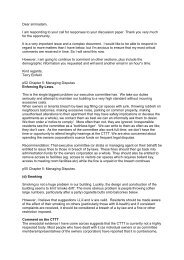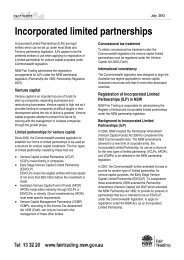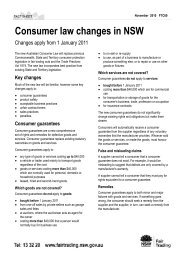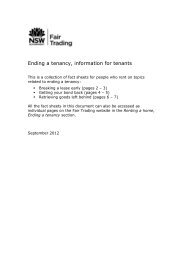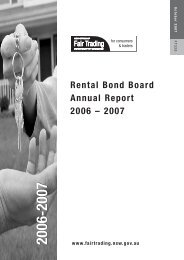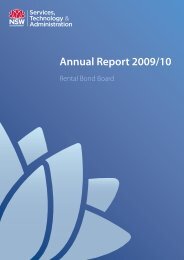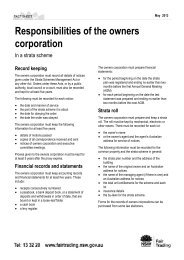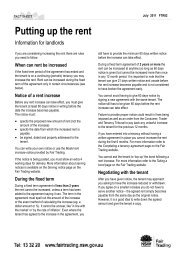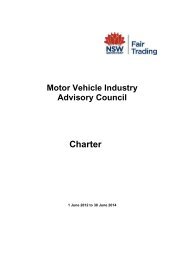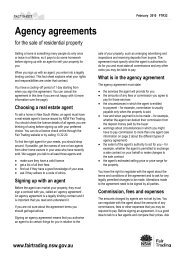Passing on water charges - NSW Fair Trading
Passing on water charges - NSW Fair Trading
Passing on water charges - NSW Fair Trading
You also want an ePaper? Increase the reach of your titles
YUMPU automatically turns print PDFs into web optimized ePapers that Google loves.
<str<strong>on</strong>g>Passing</str<strong>on</strong>g> <strong>on</strong> <strong>water</strong> <strong>charges</strong><br />
Informati<strong>on</strong> for landlords<br />
You can pass <strong>on</strong> <strong>water</strong> usage <strong>charges</strong> to your tenant<br />
provided all the minimum criteria have been met.<br />
Minimum criteria<br />
The minimum criteria for passing <strong>on</strong> <strong>water</strong> usage <strong>charges</strong><br />
are:<br />
● the rental premises must be individually metered<br />
(or <strong>water</strong> is delivered by vehicle, such as those with<br />
<strong>water</strong> tanks <strong>on</strong> rural properties) and<br />
● the <strong>charges</strong> must not exceed the amount billed for<br />
<strong>water</strong> usage by the <strong>water</strong> supplier and<br />
● the rental premises must meet required '<strong>water</strong><br />
efficiency' standards.<br />
Water efficiency standards<br />
A rental property is c<strong>on</strong>sidered <strong>water</strong> efficient if it meets<br />
these standards.<br />
Water efficient devices Minimum <strong>water</strong><br />
efficiency standard<br />
required<br />
Internal cold <strong>water</strong> taps<br />
and single mixer taps<br />
for kitchen sinks and<br />
bathroom hand basins<br />
A maximum flow rate of 9<br />
litres per minute<br />
Showerheads A maximum flow rate of 9<br />
litres per minute<br />
No leaking taps No leaking taps anywhere<br />
<strong>on</strong> the premises at the<br />
start of the tenancy or<br />
when the other <strong>water</strong><br />
efficiency measures are<br />
installed<br />
The requirement for sink and basin taps to have a<br />
maximum flow rate of 9 litres per minute does not apply<br />
to other taps in the premises, such as bathtub taps,<br />
June 2012 FTR74<br />
laundry taps, outside taps for the garden, or taps which<br />
supply washing machines and dishwashers.<br />
You do not necessarily need to change the showerheads<br />
and tap fittings. The <strong>water</strong> efficiency measures can be<br />
achieved simply by installing aerators or regulators to<br />
existing taps and showerheads and fixing any leaking<br />
taps <strong>on</strong> the premises.<br />
Proving <strong>water</strong> efficiency<br />
The presence of the <strong>water</strong> efficiency measures needs<br />
to be noted <strong>on</strong> the ingoing C<strong>on</strong>diti<strong>on</strong> report for the<br />
premises. There is no requirement to provide a report<br />
from a plumber or the <strong>water</strong> supply authority certifying<br />
their existence. However, it may help to keep:<br />
● invoices or file notes of work d<strong>on</strong>e<br />
● receipts for any items bought<br />
● packaging, warranties or instructi<strong>on</strong> manuals.<br />
If you are unsure if your existing taps and showerheads<br />
meet the required standards you could carry out a simple<br />
bucket and stop watch test to see if, when fully turned <strong>on</strong>,<br />
the flow rate is less than 9 litres in a minute.<br />
For any <strong>water</strong> fixtures made from 2005 <strong>on</strong>wards, the<br />
easiest way to check if they meet the required efficiency<br />
standard is to look for products with a Water Efficiency<br />
Labelling and Standards scheme (WELS) rating of three<br />
stars or higher. A three star rating indicates a maximum<br />
flow rate of 9 litres per minute. WELS is Australia's <strong>water</strong><br />
efficiency labelling scheme which rates fixtures including<br />
taps and showerheads according to <strong>water</strong> efficiency.<br />
Timeframe for installing <strong>water</strong><br />
efficiency measures<br />
If you are entering into a new tenancy agreement from<br />
31 January 2011, you need to ensure the premises are<br />
<strong>water</strong> efficient in order to pass <strong>on</strong> <strong>water</strong> usage <strong>charges</strong> to<br />
the tenant.
For all tenancies in place prior to 31 January 2011, you<br />
have 12 m<strong>on</strong>ths to make the premises <strong>water</strong> efficient.<br />
You will be able to c<strong>on</strong>tinue to charge existing tenants<br />
for <strong>water</strong> usage during this transiti<strong>on</strong>al period even if the<br />
premises are not <strong>water</strong> efficient. From 31 January 2012,<br />
you will need to ensure the premises are <strong>water</strong> efficient<br />
if you wish to c<strong>on</strong>tinue charging the tenant directly for<br />
<strong>water</strong> usage.<br />
Charges limited to <strong>water</strong> usage<br />
Only the <strong>water</strong> usage (volume) costs charged by the<br />
supplier may be charged to the tenant. Other costs<br />
<strong>on</strong> the <strong>water</strong> bill, such as <strong>water</strong> service or sewerage<br />
services are payable by you and cannot be charged<br />
directly to the tenant. You cannot charge the tenant an<br />
administrati<strong>on</strong> fee for passing <strong>on</strong> the bill, late fees or<br />
additi<strong>on</strong>al amounts.<br />
Asking the tenant for payment<br />
The tenant has to be given a copy of the part of the <strong>water</strong><br />
bill you receive setting out the <strong>water</strong> usage <strong>charges</strong> or<br />
some other evidence showing how you calculated how<br />
much they owe for <strong>water</strong>. You must seek reimbursement<br />
within 3 m<strong>on</strong>ths of getting the bill, otherwise the tenant<br />
doesn't have to pay. The tenant must be given 21 days<br />
to pay the amount they owe you. If you request payment<br />
within the 3 m<strong>on</strong>ths, and the tenant doesn't pay, you can<br />
still take acti<strong>on</strong> to recover the m<strong>on</strong>ey later <strong>on</strong> (eg. by<br />
making a claim against the b<strong>on</strong>d).<br />
Things to know<br />
Some important points to remember include:<br />
● If the tenant removes or tampers with the <strong>water</strong><br />
efficiency devices they still have to pay for <strong>water</strong><br />
usage.<br />
● Water billing periods are unlikely to align with<br />
tenancy agreements. It is important that the <strong>water</strong><br />
meter reading be noted <strong>on</strong> the c<strong>on</strong>diti<strong>on</strong> report at the<br />
start and end of each tenancy to accurately calculate<br />
each tenant's <strong>water</strong> c<strong>on</strong>sumpti<strong>on</strong>.<br />
www.fairtrading.nsw.gov.au<br />
<strong>Fair</strong> <strong>Trading</strong> enquiries 13 32 20<br />
TTY 1300 723 404<br />
Language assistance 13 14 50<br />
This fact sheet must not be relied<br />
<strong>on</strong> as legal advice. For more<br />
informati<strong>on</strong> about this topic, refer to<br />
the appropriate legislati<strong>on</strong>.<br />
June 2012 FTR74<br />
● These provisi<strong>on</strong>s apply to all tenancies, regardless<br />
of the terms of any existing tenancy agreements.<br />
However, tenants in social housing premises may<br />
have a different system applied for calculating and<br />
paying for <strong>water</strong> usage. C<strong>on</strong>tact Housing <strong>NSW</strong> for<br />
further informati<strong>on</strong>.<br />
● If the <strong>water</strong> usage <strong>charges</strong> suddenly go up by a<br />
significant amount, this may indicate a leak or faulty<br />
appliance in the premises requiring your urgent<br />
attenti<strong>on</strong>. It may be helpful to c<strong>on</strong>tact the <strong>water</strong><br />
supplier about average <strong>water</strong> c<strong>on</strong>sumpti<strong>on</strong>.<br />
● You cannot save up all the <strong>water</strong> bills and pass them<br />
<strong>on</strong> to the tenant at the end of the tenancy. Payment<br />
must be requested within 3 m<strong>on</strong>ths of receiving each<br />
bill.<br />
● You must pay the <strong>water</strong> supplier's bill, even if you<br />
have not yet received the tenant’s payment.<br />
● When the tenant vacates the property, check that the<br />
<strong>water</strong> efficiency measures are still in place when you<br />
complete the final c<strong>on</strong>diti<strong>on</strong> report.<br />
© State of New South Wales through <strong>NSW</strong> <strong>Fair</strong> <strong>Trading</strong><br />
You may freely copy, distribute, display or download this informati<strong>on</strong> with<br />
some important restricti<strong>on</strong>s. See <strong>NSW</strong> <strong>Fair</strong> <strong>Trading</strong>'s copyright policy at<br />
www.fairtrading.nsw.gov.au or email publicati<strong>on</strong>s@services.nsw.gov.au


